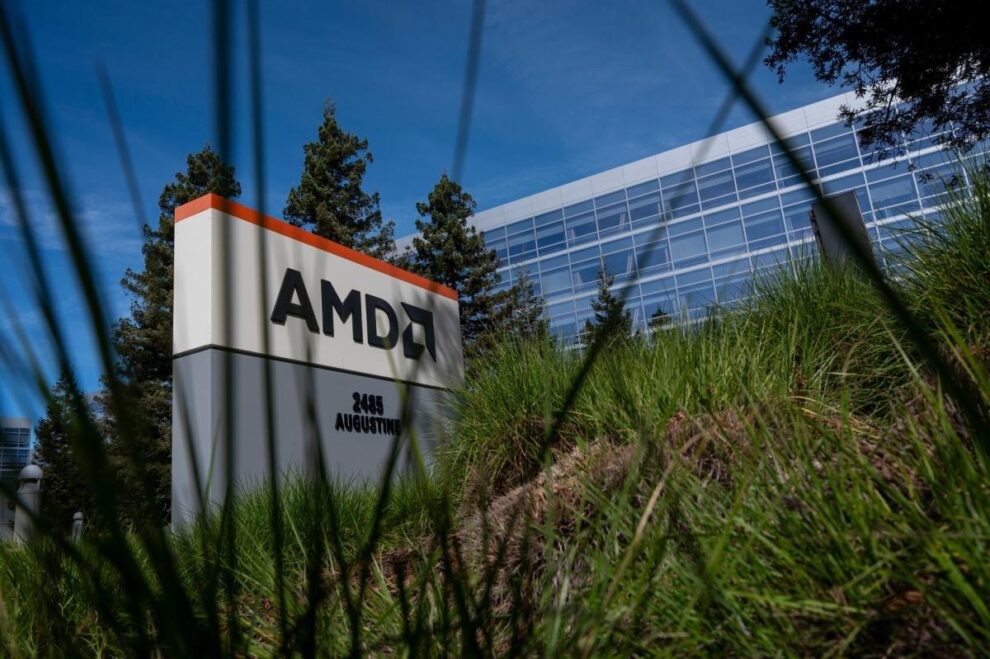
(Bloomberg) — Advanced Micro Devices Inc. shares rallied after the chipmaker gave an upbeat revenue forecast, underscoring that its new artificial intelligence processors are boosting growth.
Most Read from Bloomberg
Revenue will be roughly $6.7 billion in the third quarter, the company said in said Tuesday. Analysts estimated $6.62 billion on average. Second-quarter results also topped projections, and the company raised its forecast for so-called AI accelerators — chips used to develop artificial intelligence models.
The outlook suggests that AMD is making headway in its pursuit of Nvidia Corp., which dominates the accelerator market. Nvidia has capitalized on booming demand to send its shares and stock price soaring over the past year, becoming the world’s most valuable chipmaker in the process. Now AMD is looking to make inroads with its own lineup, called MI300.
Chief Executive Officer Lisa Su said Tuesday that AMD expects to generate more than $4.5 billion in sales from its MI300 products this year. That’s up from an earlier target of $4 billion, though analysts’ estimates have ranged closer to $5 billion. The growth reflects an effort to ramp up production, but supplies continue to be tight, she said.
Su downplayed concerns that the race to add AI infrastructure is slowing down, saying that customers are still eager to chase the opportunity.
“The overall view on AI investment is: We have to invest — the potential of AI is so large,” she said on a conference call with analysts. “The investment cycle will continue to be strong.”
MI300 revenue topped $1 billion in the second quarter, and the company committed to rolling out new AI processors once a year — a key milestone.
“We continued accelerating our AI traction,” Su said. Cloud computing and enterprise customers are embracing AMD’s Instinct MI300X products, she said. And demand is picking up for its traditional personal-computing and server businesses.
AMD’s second-quarter revenue rose 8.9% to $5.84 billion, beating an estimate of $5.72 billion. Earnings increased to 69 cents a share, compared with a projection of 68 cents.
AMD is Nvidia’s nearest rival in the accelerator market, but still trailing by a wide margin. The hope is to gain more of the money that data-center operators such as Microsoft Corp. and Meta Platforms Inc. are pouring into the creation of AI tools.
Though demand for accelerators has been strong, the appetite for some other AMD products has slowed. Embedded chips and semiconductors for gaming consoles have struggled recently.
AMD shares rose more than 7% in extended trading following the announcement. They had earlier closed at $138.44 in New York, leaving them down 6.1% for the year.
AMD’s quarterly report kicks off a week of earnings updates from large semiconductor makers. Qualcomm Inc., Arm Holdings Plc and Intel Corp. all report numbers this week, and it comes at a delicate time for the chip industry. Investors have been selling shares of the companies after a dramatic run-up earlier this year.
The Philadelphia Stock Exchange Semiconductor Index, a closely watched benchmark, is down 11% this month. For investors, excitement over AI spending has given way to concern that the infrastructure may not have a rapid payoff.
Like Intel, AMD still gets most of its revenue from personal computer and server microprocessors. Santa Clara, California-based AMD also competes with Nvidia in the market for graphics processors that improve the images in video games.
The company is the biggest rival of Intel in both server and PC processors — as well as in programmable logic chips, which can be reconfigured with software after they’re installed. And it supplies Microsoft and Sony Group Corp. with the main component in their game consoles.
AMD’s data-center unit had sales of $2.8 billion last quarter, more than double the level from a year earlier. Analysts had estimated $2.75 billion. PC chips brought in $1.5 billion, up 49%.
Gaming, meanwhile, was down 59% at $648 million. The two main game consoles that use AMD chips are now in their fifth year, AMD said. Revenue from embedded semiconductors was down 41% from last year at $861 million, hurt by weak demand from customers who have built up stockpiles of parts.
(Updates with additional CEO comments starting in fifth paragraph.)
Most Read from Bloomberg Businessweek
©2024 Bloomberg L.P.






